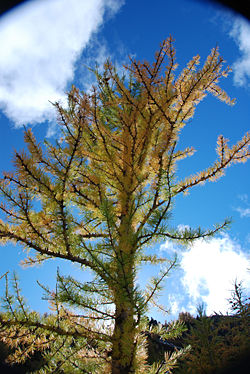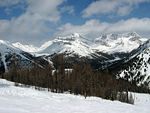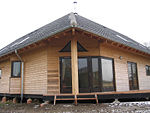Larch
| Larch |
|---|

|
| Scientific Classification |
|
| Species |
|
Larch is a conifer tree belonging to the taxonomic genus Larix, which are distributed across most of North America. A major disjunct population occurs in the interior of Alaska, between the brooks that range to the North or Alaska range to the South. It also occurs locally in the mountains of the West Virginia and Western Maryland. They are large and sometimes dominant trees in seral lowland communities. They are also used in many ways, we can find larch trees in cool, temperate regions of the Northern hemisphere.
Anatomy
The anatomy of larch trees are divided into three large sections. The first section is a transversal section. And sudden transition is made between early woods and late woods. The second section is a radial section, which is found in the cross fields of the earlywood. And the third section is a tangential section, which sometimes has two resin canals in a ray. [1]
Reproduction
For propagation of the larch trees, people sow the seeds of the Larch tree in late winter in pots in a cold frame. Then, one-month cold ground helps for buds coming out. It is the best to give the seedlings light shade for the first year. When they grew up enough to handle, prick out the seedlings into individual pots. They grow up in the cold frame for their first winter and plants will be out in early summer of the following year. The seed remains viable for 3 years. [2] This species is very cold-hardy when fully dormant, but the trees can be excited into premature growth by mild spells during the winter and they get effected to damage by late frosts and cold winds. The tree often comes into growth in January or February, so it is very susceptible to frost damage.
Ecology
Mature heights usually range from 30 to 130 feet in the United States and Canada, larger individuals have occasionally been reported, particularly from Europe. The needles are spirally arranged in fascicles of 30 to 65 needles, on short shoots. The bark of young trees are thin, smooth, and developing gaps as it matures. In older trees the bark is very flaky and heavily ridged with wide gap. [3] Larch trees exhibit rapid early growth and occasionally early senescence, particularly in mixed stands. The average age at senescence is between 100 and 150 years of age, ages of 600 years or more have been reported for larch tree in the Alps. The oldest European larch on record was 672 years old in 1955. And record height for Larch tree is reported as 184 feet in Baden, Germany. The growing periods of Larch trees are at least 100 days, longer than the other conifers. But burst occurs in early spring, before the ground has completely melted. [4]Height growth of Larch tree continues at an appreciable rate until September. The female cones appear before leaf-out in early spring and pollination occurs from March to May or June. The seed cones ripen from September to December of the same year, and the seeds are dispersed from September to spring. In Great Britain, European larch cones do not open until spring. European Larch needles die and fall off in early November, but some needles are maintained through December. The bark of Larch trees are thin, so Larch trees are probably susceptible to fire easily. Thick bark on mature Larch and the ability to produce new leafage each year may make them somewhat fire resistant. In Europe, European Larch commonly occurs in upper-elevation forest zones that rarely burn. [5]
Uses
In the United States, larch trees are not a major commercial timber species, they are used primarily for pulpwood though. Larch trees are also used normally for posts, poles, mine timbers, and railroad ties. But not that normally, they are also used for rough lumber, fuelwood, boxes, and crates. Because the larch tree woods are heaby, durable, firm, and decay-resistant. The bark tannin has been used for tanning leather. And Larch trees have also used for medicinal herbs. The winter of Siberia is very cold, so people who live in Siberia, they harvest the young Larch tree leaves in the spring and store them by lactobacillus fermentation, and they eat them for salads during winter. Larch trees are also used for the production of Venice turpentine. [6]
Gallery
 Browse |
References
- Larix laricina Fact Sheet John R. Seiler, Edward C. Jensen, or John A. Peterson. Virginia Tech.
- Larix Kaempferi Dr. Mark Brand. UConn.
- Larix decidua Unknown Author. Fed.










